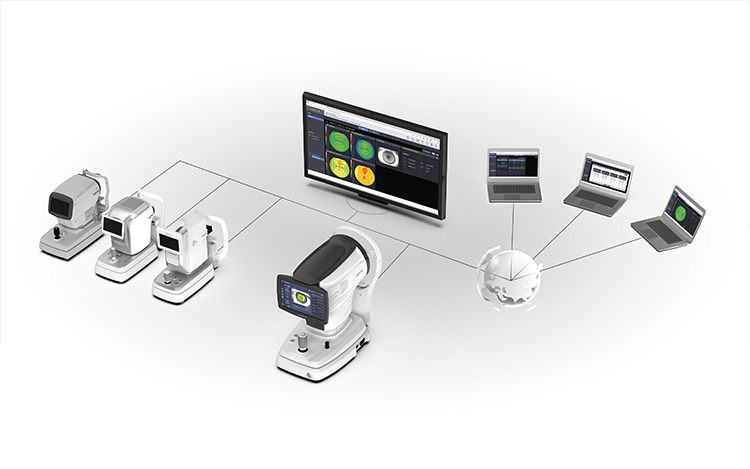Huvitz
 Inquiry
Inquiry



PRODUCT
Introducing a variety of Huvitz products sold in the global market.
- ALL
- Optical Coherence Tomography
- Optical Biometry
- Topography
- Slitlamp & Imaging System
- Non-contact Tonometer
- Applanation Tonometer
- Auto Ref/Keratometer, Non-contact Tono/Pachymeter
HBM-1
The HBM-1 is a completely integrated optical biometer with Biometry and Topography
All 10 examinations at once for cataract surgery
IOL power value calculation through the various formula
Myopia management functions for Integrated management
- Features
- Specifications
- 1. Optimal Workflow for Cataract Surgery
- Achieve the ultimate workflow for cataract surgery with the simultaneous measurement of 10 optical biometry and full corneal topography values. The correct calculation of the Intraocular Lens (IOL) Power leverages a variety of formulas, enhancing the efficiency and precision of cataract surgery planning.

- 2. Reliable Measurement Data & Value
- The HBM-1 provides biometry and topography values, consistently delivering reliable data even in cases with lens opacity in cataract patients. Featuring Dense Cataract Mode (DCM), the device enhances and recalculates weak light signals to secure dependable data in patients with denser cataracts.

- 3. Varied Range of Practical Uses
- Monitor changes in patients’ visual acuity data including alterations in axial length (AL) and refraction. It facilitates the comparison of diagnoses derived from glasses and lenses, pre and post-prescription, and supports regular management of eye care needs, such as monitoring floaters affect vision.

- 4. User-friendly Convenience
- Experience enhanced usability with the HBM-1, incorporating advanced connectivity, voice guidance and auto-tracking among other features. The comprehensive report generation capability further augments the user-friendly experience, ensuring smooth operation for practitioners.

- 1. Biometry
| Parameter | Measuring range | SD of Repeatability |
|---|---|---|
| Axial length | 14–40 mm | ±0.025 mm |
| Anterior chamber depth | 1.5–6.5 mm | ±0.04 mm |
| Central corneal thickness | 0.25–1.3 mm | ±0.02 mm |
| Crystalline lens thickness |
1.5–6.5 mm (phakic) 0.5–3.5 mm (pseudo-phakic) |
±0.06 mm |
| Wavelength | 835nm | - |
| White-to-white distance | 7–14 mm | ±0.05 mm |
| Pupil diameter | 0.5–10 mm | ±0.05 mm |
- 2. Keratometry
| Parameter | Measuring range | SD of Repeatability |
|---|---|---|
| Corneal curvature radius | 5–13 mm | ±0.03 mm |
| Cornea refractive power | 25.96 D–67.50 D (Cornea equivalence's refractive index:1.3375) |
- |
| Direction of principal meridians |
Measuring range:1°–180° Accuracy:according to the ISO 10343:2014 |
- |
| Crystalline lens thickness |
1.5–6.5 mm (phakic) 0.5–3.5 mm (pseudo-phakic) |
±0.06 mm |
| White-to-white distance | 7–14 mm | ±0.05 mm |
| Pupil diameter | 0.5–10 mm | ±0.05 mm |
- 3. Corneal Topography
| Working distance | 80 mm |
|---|---|
| Placido disc | 24 rings |
| Points Analyzed | Over 100,000 (Measured points:Over 6,220) |
| Measuring accuracy | Type A according to the ISO 19980:2012 |
| Cornea coverage | up to Ø 9,8 mm (on a 8 mm sphere) 42,20D with n=1.3375 |
- 4. Common
| Biometry light source | 835nm |
|---|---|
| Display | Tiltable 10.1 inch, Touch panel color LCD |
| Horizontal movement | 45 mm (back and forth), 100 mm (left and right) |
| Vertical movement | 30 mm |
| Chinrest movement | 62 mm (up and down), motorized |
| Auto tracking | X,Y for positioning, Z for working distance |
| Power supply | AC 100–240 V, 50/60 Hz, 1.6–0.7 A |
| PC | Built in computer |
| Dimensions | 302(W) x 506(D) x 510(H) mm |
| Mass | 22 kg |
- 5. Software Features
| IOL | IOL calculator, IOL editor |
|---|---|
| Keratoconus | KPI |
| Contact lens fitting | Fluorescein simulation |
| Zernike Analysis | - |
| Myopia Management | - |
- ** Specification and design are subject to change without notice.






